 June/July, 2011 - Vol. 25, No. 1.
June/July, 2011 - Vol. 25, No. 1.
 April/May, 2011 - Vol. 24, No. 6.
April/May, 2011 - Vol. 24, No. 6.
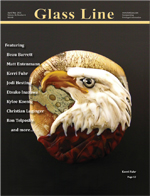 |
In This Issue
Sculpting a Humpback Whale in 33 COE by Matt Entenmann –
For this article/tutorial, I have focused primarily on the mother because the calf follows the same steps, just in miniature. In addition, alternating between mother and calf will help ensure proper annealing and help with time economy ...
Swan Bead Tutorial by Kerri Fuhr –
I discovered early on that glass is really just molten “paint” and can be manipulated in similar ways to achieve a painterly effect. I love nature, so many of my beads are miniature glass “paintings” that depict the natural world around me. Birds, horses, insects, and wildlife are my favorite subjects to depict in glass ...
Making a Helicoid Bead by Beau Barrett –
In a session of experimentation with some sleeved sections, I had an idea that proved to be fruitful. I took a simple style of bead that I had made many times and adapted it for encasement with a sleeve. I had never before seen anything like this done and was pretty stoked with the results and future possibilities.
This is a tutorial for a bead, but is also a recipe that could be scaled up for a tube-pull that makes some unique “groove tube.” It can also be condensed completely to form a marble
...
"Southwest Silver" by Jodi Hesting –
Turquoise is quite popular here in the Southwest and is mined locally in many surrounding areas. Local Native American artists create such beautiful jewelry in silver, which showcases turquoise. The beads described here draw on my love of the silver and turquoise combination, and of the Arizona Southwest. I hope you will enjoy making them along with me! ...
Cherry Blossoms Bead with Buds by Tetsuya Kurosawa –
(Japanese bead tutorial) There are many steps to make this bead so take your time and perform each task in a careful manner ...
Finding a Calling in the World of Glass (Filip Vogelpohl) by Kylee Koenig –
Here is the method that Vogelpohl uses to create a tribal head using ordinary tools. "There are thousands of designs that you can incorporate into your sculpture," he said. "This is merely one design— don’t be afraid to add some of your own details. I hope you enjoy this process. May it inspire you to go in different directions"
...
A Champs Journey by Christian Luginger –
Sometimes a tight deadline can result in literally an award-winning piece of glasswork. That was the case recently when I had the opportunity to create a new piece for a major show. Teamwork made a big difference with this project ...
Creating Sea-life Sculpture with Basic Techniques by Ron_Telposky –
This project is a combination of every tutorial I have ever read, from goblet-making to pendants and icicles. I am inspired by the work of others and I hope to inspire others with this sculpture. Have fun in all you do! ...
- Glassified Ads - April/May, 2011
- Vol.
24 No. 6.
- Workshop Calendar
|
 February/March, 2011 - Vol. 24, No. 5.
February/March, 2011 - Vol. 24, No. 5.
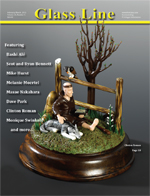 |
In This Issue
Making a Hollow Boro Shell Pendant by Mike Hurst –
I have always liked seashells. The shapes, colors and patterns of seashells found in nature are fascinating. For the past several years, I have been trying to figure out how to make a realistic-looking seashell pendant in glass, but I was never happy with how they turned out.
Recently, I was doing demos at a show with a good friend, Roger Child. Roger makes great sea-life sculptures. He made a few shells over the course of our demo, and was gracious enough to show me how he makes them. Since then, I have been hooked on making my own. I came up with this style
...
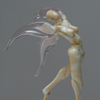
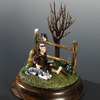
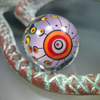
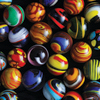
The amazement for me started when I was introduced to collecting vintage machine-made marbles a few years ago. Toy marbles, more specifically, made for children to play simple games during a simple time. I began to focus on marbles made during the early to mid-20th century. The colors were bright, and the color separations were crisp
...
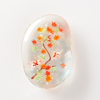
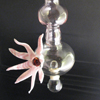
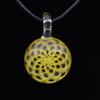
Copper Electroformed Plant using Color Blowout (Flameworking step-by-step tutorial) by Dave Park – This demonstration will show how to build a copper electroformed glass plant with a steel base. The featured glass technique is known as a “blow out,” represented by the color portion of the plant. I would like to thank Christopher McElroy for introducing me to this technique. Kate Fowle Meleney is a good resource for maintaining an electroforming setup. Thanks to Troy Bennett for letting me hop into his electroforming schedule for this piece ...
- Glassified Ads - February/March, 2011
- Vol.
24 No. 5.
- Workshop Calendar
|
 December/January, 2010/11 - Vol. 24, No. 4.
December/January, 2010/11 - Vol. 24, No. 4.
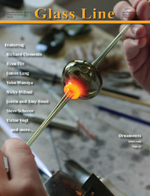 |
In This Issue
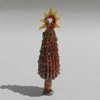
After working in a tile factory for several years to feed his need for glass, Mifsud moved back to his home country of Malta and opened a small glass-sculpturing business, Glass Creations, creating pieces for weddings, birthdays, and special occasions, as well as unique pieces. Although the business was thriving, Mifsud’s personal life changed dramatically due to developing macular degeneration, and he returned to Australia in 1999, with his glass sculpturing work arranged with Kuranda Glass, North Queensland. He has travelled across the globe transforming his work into collector’s pieces, including basic lampwork techniques and lacework.
Recently, a piece by Mifsud was a finalist for the Australian Ranamok Glass Prize and has been acquired by Corning Museum of Glass, Corning, NY. He continues to create pieces using clear borosilicate with a touch of color. Although macular degeneration is slowing taking away his sight, he and his wife Nicky are determined to keep his glasswork dream alive.
With the holidays approaching, the Mifsuds offer this project for colleagues to consider adding to their repertoires
...
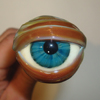
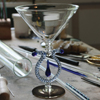
In the meantime, this martini “goblet” would make an ideal gift item for the coming holiday season ...
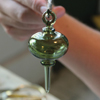

Making a Peacock Pattern Top with an Opal for a Titanium Bottle-stopper ...
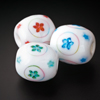
They are commonly called “Firefly Bead.” This technique gives the transparent murrine different dazzle. The transparent colors and refraction of light makes a cool effect and can surprise you with unpredicted colors depending on the combinations of the colors.
Why don’t you try it out? ...
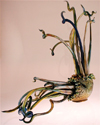
Then the fun began. I had not made one of these for more than ten years and I had forgotten so much, like the best way to thicken up the back, the length of the spear, how far to blow the body so the spines would fit without falling out and so much more that it took three days before I felt almost comfortable with what I was doing. I never realized how much work it would take to make all 22 of them; it seemed to go on forever—they took the best part of three months to finish.
I had never taken on anything like this in my working life, and it nearly drove me crazy. My working style (when I am not making bottles) is to flitter from one thing to another, which gives me great pleasure. I can be making a mask and I will think of a design for a wine glass; while making the wine glass, something else will pop into my mind and off I go in a different direction. I have concluded, after many years of work, that this should not be encouraged, as it is not a very efficient way to work, but I doubt if I can change now.
It was with a huge sense of relief and satisfaction that I saw the last urchin packed for delivery. The hotel is very happy with them, which makes me very proud.
The idea of doing a “how to do” is not necessarily for anyone to make one, if you are silly enough be my guest, but to give someone an idea for going off in a different direction. I apologize for not having the pictures of the completed body but, just as I finished it and I was holding it so the final shot could be taken, it decided to go crazy and jumped off the punty. It landed on one of my tools, which should not have been there (as you can see by the state of my bench, I am a great believer in the chaos theory), and promptly broke into unfixable pieces. Such is life! ...
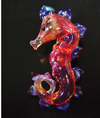
We are delighted to share this project with colleagues ...

In preparation, I made a series of rods of different diameter of TAG Elvis Red by mixing a 10-inch length of Elvis Black with a 5-inch length of 1-inch diameter rod. This will allow me to pull rods of about 12, 8 and 5 mm diameter ...
- Glassified Ads - December/January, 2010/11
- Vol.
24, No. 4.
- Workshop Calendar
|
 October/November, 2010 - Vol. 24, No. 3.
October/November, 2010 - Vol. 24, No. 3.
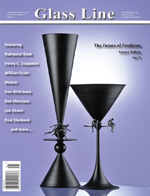 |
In This Issue
A Step-by-step Tutorial on Filachellos - by Nathaniel Dark – After taking classes with artists Freeek and Eusheen, I have learned two different ways to make a filachello (also called filacello) design. The steps are the same, but each uses a different size of tubing at the start. For practice, I started with just two colors—one for the line work and one for the fill. Once I had a good handle on getting the lines and fill consistent, I started playing with alternating colors for the fill and changing the number of lines I start with.
Start by pulling consistently thin stringers of the various colors you plan to use; more than you think you will need is best ...
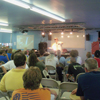
Many “old-school” flameworkers were there, such as Bandhu Scott Dunham (a building was dedicated to him at AGI 2010), Robert Mickelsen, Roger Parramore, Doni Hatz, and Henry Grimmett, who all gave very informative lectures and demos
...
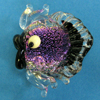
My early attempts were pretty bad. I tried to throw them away, but my wife kept retrieving them so I would remember my beginnings. Little changes would occur, seemingly on their own, as I continued to make fish beads over and over again. I tried to make ...
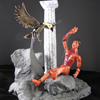
How does an artist create art in a time when money and material ways are honored as never before in history?
...
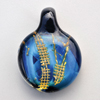

“We have one of the largest populations of glassblowers in Colorado, but they weren’t very connected,” said Mueller, founder and president of the Colorado Project. Mueller has worked with glass since 2001 and is manager at Glasscraft in Golden, CO. He is joined in leading the CoProj by his wife Lauren Mueller, along with Corinne Winters, Kristina Sasser, and Adam Grafuis.
“People here have been keeping to themselves, wanting to protect their buyers from other glassblowers,” said Mueller. This conspiracy of silence is old news in glasswork—for centuries, the secrets of glassblowing were carefully guarded on the island of Murano. Tradition or not, that “glass wall” limits what an artist can achieve on his or her own, Mueller says
...
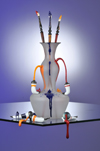
Working at the torch on the islands of Murano and Venice are three world-class masters, Césare Toffolo, Lucio Bubacco, and Vittorio Costantini, who are creatively advancing their island’s centuries-old Venetian glass tradition. As I sit at my torch 4,000 miles away, melting glass by the same process, I celebrate our flameworkers’ tribe with this new breed of glass artist that is adding a new chapter to glass history. Like Césare, I have been creative within a centuries old tradition and can relate to his challenges
...
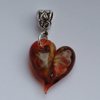
Being a freelancer allowed me to pursue artistic activities such as silk painting, leatherwork, watercolor, and stained glass, to name a few. I was always hunting for new means of artistic expression
...

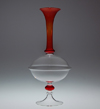
For the vase itself, I hope to achieve a round, straight, precise shape—technically challenging, and symmetrical. It was also my intention to make these shapes as large as I could. I found myself using a section of tubing as long as I was able to handle and seeing how big of an even shape I could produce. Although many of the ideas or objects I would like to make appear to be intimidating or too challenging, almost every time, the effort becomes a rewarding experience. The things that seem unreachable are actually very much achievable if they are simply attempted ...
- Glassified Ads - October/November, 2010
- Vol.
24 No. 3.
- Workshop Calendar
|
 August/September, 2010 - Vol. 24, No. 2.
August/September, 2010 - Vol. 24, No. 2.
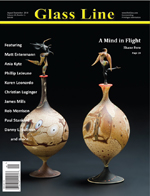 |
In This Issue
- A “Pointless” Goblet
- by Danny L. Sullivan –
I will share some of the tips and techniques that I have acquired for creating a goblet stem and then combining it with a premade bowl and foot to create a unique goblet ...
- Standards of Quality: Essential features of great lampwork beads!
- by Ania Kyte –
As a beadmaker, I am critical about inspecting my beads to make sure they have the best qualities before they go out into the world; as a bead collector, I am careful about selecting beads on which I’m willing to consider spending my hard-earned money. This article outlines some of the criteria that I use for deciding on the essential features of an artglass bead. I hope these standards of quality will guide both beadmakers and collectors in making their bead-related decisions ...
- Sculpting with 33 COE (Octopus sculpture tutorial)
- by Matt Entenmann – After about a year, experimentation turned into my job and I have never looked back.
Borosilicate is a great medium for sculpting. The ability to support the molten glass from both sides offers a lot of control. In addition, low-coefficient of expansion (COE) glass is resistant to cracking as long as you keep your working time relatively short and let it anneal properly when parked in the kiln ...
- The Heat Sun Focal Tutorial (Soft glass bead tutorial)
- by Karen Leonardo –
My Heat Sun Lentil has a beautiful bright glow in striking red, yellow, and orange, with organic movements of earth or sand caused by reaction to its foiled goldstone stringer. The gold or red dichroic adds a bit of sparkle and bling and creates the sense of a little blast of heat ...
- A Mind in Flight: An Appreciation for Shane Fero
- by Paul Stankard –
I knew of Shane Fero’s work for awhile, but first met him in 1991 at the Corning Museum of Glass (Corning, N.Y.), while attending a Glass Art Society (GAS) conference. Shane was standing at the display of ancient glass and his name tag gave him away. When I introduced myself, it was evident we both respected each other’s work – the conversation opener was about how variations on today’s flameworking techniques can be found in a few fragments from the earliest examples of glass-making. I became deeply impressed with Shane’s historical knowledge of glass and his special interest in early lampworking history ...
- Squished Frog Shots
- by James Mills –
A few years ago, a coworker of mine had bought a few shot glasses I made with little frogs stuck to the sides. She liked them so much that she asked if I could make her a couple more for her brother as a Christmas gift, so I told her I would love to make them for her. Well, days turned to weeks; it was getting closer and closer to Christmas; and I still had not even started on them. In the meantime, she had been bugging me about them every day for weeks.
One day, I finally said. “You know what, I’m going to take that dang frog and squish him under the shot glass. His head is going to be sticking out from the bottom and his legs will be holding onto the sides of the glass, and there will be blood and guts all over the bottom.” Her reply: “I like it, my brother will love that.” Off I went to create my very first squished frog shots. Here’s how they work ...
- A Brief History of Glass and Flame One
- by Christian Luginger –
Here at Flame One, over the last eight years, we have been continually pushing the limits to be innovative and creative to keep up with new ideas and mainstream art projects around the globe.
When I first saw Dale Chihuly on PBS 10 years ago, I would have never imagined the exciting journeys my glass career would take me on … meeting so many people, going so many places, and, yet, so many more years ahead to go. As I learned about the different types of glass-making throughout history, something stood out to me about the past 500 years about Venetian and Renaissance blown glass, which includes chandeliers, goblets, épergnes, jewelry, and paperweights. Somehow, I have a connection with these forms and shapes and, through independent study, I’ve spent years making these types of pieces to enjoy for myself and to share with others. During the next year and upcoming years, I will be focusing on a mix of classic and contemporary styles of art and ways to bring them back to be enjoyed in public viewings and private collections. This is some of the research that I’ve put together for a brief history lesson of tableware and the blown-glass épergne. I hope you enjoy my findings ...
- Finding your niche market
- by Phillip LeJeune –
My father, John Paul LeJeune, always preached about the quality and flow in many of his designs and, more importantly, veering from the mainstream to create art that is different and unique. I took that to heart, learning to take my life’s experiences and translating them into glass sculpture.
Some of my work comes from the experiences of others. For instance, I was approached by a young Marine friend about creating the Marine emblem – the Eagle, Globe, and Anchor (image 1) in glass. As happens often, my first attempt was pretty pathetic compared to how it turned out today. On a trip to Camp LeJeune (I found out that General LeJeune did indeed come from the same geographical area of Belgium as my family, but can’t make the connection … yet), the piece caught the eye of the newly appointed commandant of the Marine Corps and I ended up providing this item to the Pentagon as gifts to important individuals ...
- Journeying from Craft to Art (Part 1 of 2)
- by Rob Morrison –
The past two years of flameworking have been a whirlwind of information, technical experience, and artistic growth. If you have been following my articles, you know that my focus in flameworking has shifted from marbles to sculpture. I have tried to grow from a craft person to an aspiring artist.
Over the course of my first 18 months back on the torch, I took classes with Sabina Boehm, John Kobuki, Josh Sable, and Suellen Fowler (twice), as well as spending two months working for Kaj Beck. During that period, I amassed a lot of technical experience; I was searching for that one technique that I could market. A very common mindset for craft people ...
- Glassified Ads - August/September, 2010
- Vol. 24, No. 2.
- Workshop Calendar
|
 June/July, 2010 - Vol. 24, No. 1.
June/July, 2010 - Vol. 24, No. 1.
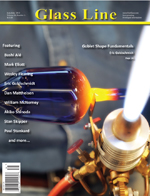 |
In This Issue
-
Golden Blossom
- by Stan Skipper –
This tutorial will show you how to make a marble consisting of an implosion flower on clear tubing ...
-
A Reading List
- by Paul Stankard –
This short reading list blends philosophical attitudes about art-making; the technical challenges involved in art-making; and the goals, egos, and lives of individual artists throughout history, but it is by no means complete or universal. These are simply books that were recommended to me throughout my professional life by people whom I respect. Each of these works helped me grow with artistic maturity and reinforced the idea that reading about artists, art-making, and the creative process will benefit other creative people’s careers ...
-
Goblet Shape Fundamentals
- by Eric Goldschmidt –
When I teach a goblet class, I find it important for the students to understand the concept of solving their own problems for any shapes they may wish to make in their future endeavors. If I can get some fundamental theories on how to create different shapes across to them, they should be successful in their work when they get back home. Working in a sequence that is consistent, with some constant primary thoughts behind the process, can take a lot of the guesswork out of the process ...
-
Soulful Consideration
- by Wesley Fleming –
Every now and then, most of us reach a plateau with our art that can be tough to break through. I recently came out of such a slump, and several friends have expressed similar frustrations. As I gained insight into what was blocking me, I discovered a new sense of meaning for the actual function of my work, and my purpose as an artist.
My slump was triggered by seemingly contradictory motivations of creating art and making money. I can get too locked into a production mode, feeling the need to produce to fill orders and pay the bills. Unfortunately, this isn’t very motivating or inspiring, and I become like a hamster in a wheel—going in circles, not actually able to focus or get much done, despite a feeling of expending a lot of energy
...
-
Dolphins Playing
- by William “Crystal Bill” McNerney –
For this tutorial, imagine a pair of dolphins (one adult and one juvenile) leaping out of water to play with a beach ball. The beach ball will be a hollow glass sphere, the dolphins will be solid with blue highlights. and the water is represented by crocheted glass. Some of this idea came from a wonderful illustrated book entitled Flameworking, by Matsumura Kiyoshi ...
-
Nebula wine stopper
- by Dan Mattheisen –
This demonstration shows how to create an elegant, dishwasher-safe, silver-imploded Nebula stopper that will last for years to come ...
-
“Nuclear Sea Anemone” Marble
- by Bashi Alé –
Recently, I was fortunate to purchase a small amount of Uranium glass from the legendary Lewis C. Wilson (www.crystalmyths.com). I immediately set out to make marbles with this new material. The first design that came to mind was this air-trap implosion (Sea Anemone) style marble. ...
-
Tombodama Techniques (AKIKO SHINODA) (Japanese Beads)
- by Takayuki Matsuzawa –
Almost all the techniques Akiko uses were self-taught. Her style which she calls “Akiko style” is very personal and gives her beads a warm feeling ...
-
Improvisation in borosilicate glass
- by Mark Eliott –
You must have a plan! As glass artists, most of us have heard this very early on—but is it true?
We collect recipes from our teachers, books, YouTube, or wherever—and with good reason. If you have a specific object you want to make, be it part of a “production run” or a “one-off” piece of art, things are going to go more smoothly if you know in advance the sequence of procedures you will use and only vary it occasionally. As a fellow student of this wonderful art/craft, however, I would like to put this question to you: How often have you picked up a rod or tube, put it in the fire, and gone on an unplanned journey—like a kid handling a new toy for the first time—with no idea of where you’re going; “flying by the seat of your pants”?
...
-
International Flameworking Conference celebrates 10th anniversary
- by Tracy Wiggins –
A reunion of previous featured masters and honors for Paul J. Stankard were highlights of the Salem Community College (SCC) 10th International Flameworking Conference (IFC).
More than 400 glass enthusiasts from across the country and around the world gathered from March 19–21 at the Paul J. Stankard Studio & Lab in Alloway, NJ, to celebrate excellence in glass art. Noted glass artist and author Stankard is the founder and chair of the conference
...
- Glassified Ads - June/July, 2010
- Vol. 24, No. 1.
- Workshop Calendar
|
 April/May, 2010 - Vol. 23, No. 6.
April/May, 2010 - Vol. 23, No. 6.
|

